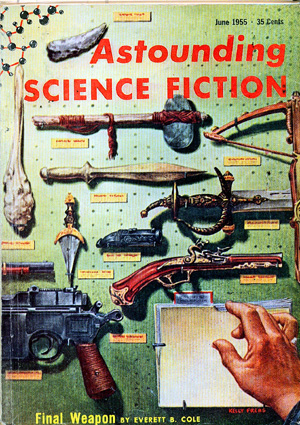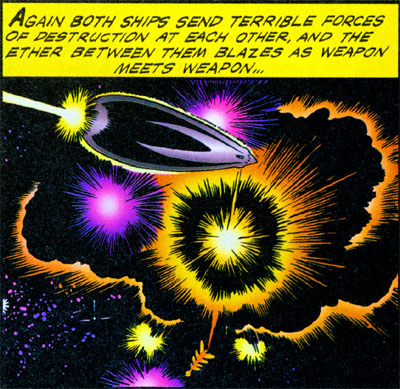-
Artwork by Russ Mannings for "Captain Johner and the Aliens", 1963. Based on "First Contact" by Murray Leinster, 1945
Introduction
-

Artwork by Malcolm Smith, Imagination Magazine, October 1953
When it comes to weapons, it looks like three main types: beam weapons, kinetic weapons, and missiles. Beam weapons are lasers and particle beams. Kinetic weapons are coilguns, railguns, and shrapnel weapons. Missiles are, well, missiles. Ken Burnsidecompared it to a policeperson armed with a service revolver, a shotgun, and a police dog. The revolver (beam weapon) cannot be dodged or outrun, but can miss. The shotgun (kinetic weapon) is more likely to hit, but with reduced lethality. The dog (missile) can be dodged or outrun (or shot, that would correspond to point defense), but the blasted thing will chase you, and will always hit unless you actively prevent it.
(Holger Bjerre begs to differ. He points out that kinetic weapons areless likely to hit since it can be dodged, beam weapons lose lethality with range just like shotguns, and kinetic weapons do not lose lethality with range just like revolvers. Well, no analogy is perfect...)
Dave Bryant has his own analysis of spacecraft weaponry here. I'm not sure I agree with all of it, so do your own research.

One of the problems with figuring out how ships are going to fight in space (assuming that we have ships in space, which isn't as likely as I wish; and, that we're still fighting when we get there, which is unfortunately more probable) is that there are a lot of maritime models to choose from.
It's also true that some of the maritime models came from very specialized sets of circumstances; and a few of them weren't particularly good ideas even in their own time.
And it's also true that some of the writers applying the models have a better grasp of the essentials than others. For example, I recall two essays which were originally published about fifty years ago inAstounding.
In the first of the essays ("Space War", Astounding Science-Fiction, Aug 1939), Willy Ley, a very knowledgeable man who had been involved with the German rocket program, proved to my satisfaction that warships in space would carry guns, not missiles, because, over a certain small number of rounds, the weight of a gun and its ammunition was less than the weight of the same number of complete missiles. The essay was illustrated with graphs of pressure curves, and was based on the actual performance of nineteenth-century British rocket artillery ("the rockets' red glare" of Francis Scott Key).
As I say, the essay was perfectly convincing ... until I read the paired piece by Malcolm Jameson ("Space War Tactics", Astounding Science-Fiction, Nov 1939).
Jameson's qualifications were relatively meager. Before throat cancer force him to retire, he'd been a United States naval officer -- but he was a mustang, risen from the rank, rather than an officer with the benefit of an Annapolis education. For that matter, Jameson had been a submariner rather than a surface-ship sailor during much of his career. That was a dangerous specialty -- certainly as dangerous a career track as any in the peacetime navy -- but it had limited obvious bearing on war in vacuum.
Jameson's advantage was common sense. He pointed out (very gently) that at interplanetary velocities, a target would move something on the order of three miles between the time a gun was fired and the time the projectile reached the end of the barrel.
The rest of Jameson's essay discussed tactics for missile-launching spaceships -- which were possible, as the laws of physics proved gun-laying spaceships were not. Ley could have done that math just as easily. It simply hadn't occurred to him to ask the necessary questions.
(Ed note: Malcolm Jameson wrote another essay with the intriguing name "Space-War Strategy" in Super Science Novels Magazine, March 1941. If you have a copy of this, please get in touch with me.)


"This is a training flight to trans-lunar space with landing at Dianaport. Request permission to pass within five kilometers of you."
"Training flight? Hah!" Omer exclaimed. "Chung has give us an escort!"
"Yes, but why?" I wanted to know. "What's going on dirtside that we should know about?"
Omer shrugged. "Let Chinese escort us. It will discourage more hassle."
If the Chinese cosmolorcha wanted to escort us, there was nothing we could do about it. It was armed. Cis-lunar space is no place to get whanged; it's a long time to anywhere.
"Permission granted, Heavenly Lighting," I replied. "Be advised you are within our zone of damage if we should have a catastrophic failure." The last was pure bluff, but nobody wanted to be near a space vehicle if it catoed, regardless whether it was due to an internal or external cause.

Engagement Envelopes

Weapon Engagement Zone
In air defense, airspace of defined dimensions within which the responsibility for engagement of air threats normally rests with a particular weapon system. Also called WEZ.
- A. Fighter Engagement Zone
- In air defense, that airspace of defined dimensions within which the responsibility for engagement of air threats normally rests with fighter aircraft. Also called FEZ.
- B. High-Altitude Missile Engagement Zone
- In air defense, that airspace of defined dimensions within which the responsibility for engagement of air threats normally rests with high-altitude surface-to-air missiles. Also called HIMEZ.
- C. Low-Altitude Missile Engagement Zone
- In air defense, that airspace of defined dimensions within which the responsibility for engagement of air threats normally rests with low- to medium-altitude surface-to-air missiles. Also calledLOMEZ.
- D. Short-Range Air Defense Engagement Zone
- In air defense, that airspace of defined dimensions within which the responsibility for engagement of air threats normally rests with short-range air defense weapons. It may be established within a low- or high-altitude missile engagement zone. Also called SHORADEZ.
- E. Joint Engagement Zone
- In air defense, that airspace of defined dimensions within which multiple air defense systems (surface-to-air missiles and aircraft) are simultaneously employed to engage air threats. Also called JEZ.


Engagement Envelopes
All battles in space take place at what are, by groundside standards, extremely long ranges, measured in ten-thousands, hundred-thousands, or millions of miles. Not only do these battles take place outside visual “eyeball” range, but even starships in the same formation are outside visual range of each other, being hundreds or thousands of miles apart. (Closer formations would pose both an unacceptably high risk of collision under battle conditions, when ships in the formation are drunkwalking independently, and would be likely to cause point-defense fratricide.)
The only exception to this rule are autonomous kill vehicles (AKVs) themselves (even when not acting as auxiliary kinetic energy weapons (KEWs)), which often come within single-digit mile distances of their targets; i.e., operating effectivelyinside the innermost point-defense zone.
Outer Envelope: The Wolves at Hunt
The outer engagement envelope begins, depending on various environmental factors, at between one to one-half light-minutes range.
Battles taking place in the outer engagement envelope are essentially always inconclusive. While historical examples of lucky hits from these ranges do exist, the probabilities of such are sufficiently low that no-one would count on them; and at such ranges, it is virtually always possible for the weaker opponent to disengage at will.
(The exception being, of course, when someone has managed to sneak an observation platform in close to the opposing force without them noticing it, which gives them a great – albeit temporary – advantage in generating long-range firing solutions.)
Rather, the purpose of engagements in the outer envelope is to wear down an opponent closing upon one’s inner envelope, forcing them to generate heat and expend point-defense resources; and to herd opponents away from the danger zones generated by one’s fire.
While it is impossible, without both fortunate geometry and superior acceleration, for a single force to bring an opposing force to battle if it is actively trying to refuse such, it is sometimes possible through strategic outer-envelope engagement and misdirection to force them to pass through the inner engagement envelope of one of a set of multiple forces (including, for this purpose, fixed system defenses). This is the end to which tactics are directed in the outer engagement envelope.
At these ranges, the primary weapons are the spinally-mounted mass drivers of larger ship classes. Carriers may attempt to use “missiles” – actually strap-on, discardable thruster packs – to deliver AKVs close in to the opposing force, but many captains prefer to reserve their AKVs for inner-envelope battles where they can be better supported.
Inner Envelope: Let’s Dance
The inner, close-range engagement envelope – in which actual battles are fought – begins at roughly a light-second of separation. This reflects the difficulties of accurately targeting an opponent engaged in active evasion (drunkwalking, ECM, etc.) when the light-lag is greater than that; essentially, you have to close to within a light-second to get a firing solution whose hit probability is significant.
Reaching the inner engagement envelope implies either that one party is attacking or defending a specific fixed installation (such as a planetary orbit, drift-habitat, or stargate), or that both parties have chosen engagement. It is relatively rare for such battles to take place in open space otherwise, since in the absence of clear acceleration superiority, it is usually easy for the weaker party to disengage before entering their opponent’s inner engagement envelope. The only way to guarantee that an opponent will stand and fight is to attack a strategic nexus that they must retain control over.
Within the inner engagement envelope, all weapons come into play. Light lag becomes low enough that information warfare can come into play in full force, firing solutions are usually possible on all craft, and AKVs have the range and maneuverability to be committed.
As the opposing forces enter the inner engagement envelope, larger ship classes typically keep their distance, maintaining formation and lateral drunkwalk evasion, as they engage in mass driver artillery duels.
Cautious admirals also hold their screening forces back at this point, preferring to weaken the enemy force before pressing further. More aggressive admirals press in immediately, moving their lighter squadrons into the center of the battlespace and deploying AKVs likewise.
Unlike the larger ships, cruisers maneuver aggressively for advantage, forming the characteristic “furball” as fleets intermingle; once this stage is reached, it becomes very difficult to retreat in good order. Cruisers attack each other with close-in, off-bore mass driver projectiles and heat-pumping lasers; the highly maneuverable destroyers and frigates engage in “wolf-pack” tactics throughout the battlespace, both targeting each other, and swarming damaged larger ships at relatively close range.
Knife-fight Range
Any battle in which the battlespace is smaller than a tenth of a light-second in diameter is referred to as taking place at “knife-fight” range. Such engagements usually occur around fixed points when the attack is pressed hard, are short and vicious, and typically result in extraordinarily high casualties – usually for both sides.
Defeat
Unlike starship armor, neither the point-defense laser grid nor the kinetic barriers are subject to direct attrition; if subjected to low-volume or low-power incoming fire, either or both could continue to destroy or repel it essentially forever.
In order to defeat these defensive systems, it is necessary to swamp them; to concentrate incoming fire to the point at which the defensive systems are unable to handle it all simultaneously. At this point, attrition may take effect as kinetic effectors and laser emitters are destroyed, but more importantly, it generates heat.
Heat is the primary limitation on combat endurance. Maneuvering burns, the use of high-energy equipment such as the point-defense grid, the kinetic barriers, and so forth, as well as the ship’s normal operation, all produce heat. In combat – when the ability to radiate heat is limited, usually to radiative striping and small (and exhaustable, if the starship is forced to maneuver) droplet radiators alone – military starships generate heat more rapidly than they can radiate it to space. As heat increases beyond the critical point, the efficiency of onboard equipment begins to fall (processor error rates rise, for example, and tactical officers must conserve their remaining heat capacity), some equipment goes into thermal shutdown, and the crew spaces become increasingly uninhabitable.
While some starships in any major space battle are destroyed physically, reduced to hulks, the majority of starships are defeated by either heat-induced equipment failure, or by being forced to surrender and deploy radiators lest their crew literally cook.


So, while it now seems to have disappeared from the Internet, my article on Non-Standard Starship Scuffles appears to have come in for some little criticism:
First, for having FTL in it; and
Second, for assuming that space battles will take place in open space, the commenter apparently not seeing any reason why they would ever take place except right next to whatever strategic nexus point they’re fighting over.
To a degree, on both points, I’m inclined to question the reading that gave rise to those comments because on the first, well, while there is mention of FTL communications with observation platforms to improve one’s longscan for tactical advantage, the ships themselves don’t – can’t – move at FTL speeds, and indeed, the entire rest of the article would be exactly the same if there were no such thing as a tangle channel.
On the latter, though, I first note this:
Reaching the inner engagement envelope implies either that one party is attacking or defending a specific fixed installation (such as a planetary orbit, drift-habitat, or stargate), or that both parties have chosen engagement. It is relatively rare for such battles to take place in open space otherwise, since in the absence of clear acceleration superiority, it is usually easy for the weaker party to disengage before entering their opponent’s inner engagement envelope. The only way to guarantee that an opponent will stand and fight is to attack a strategic nexus that they must retain control over.
…but let’s ignore that for a moment. Here’s why starship battles, whenever possible, are conducted in open space despite this, and why the inconclusive engagement-avoidance-and-retreat is also more common than the aforementioned at-nexus-point battle.
Because in space, a weapon once fired continues on until it hits something. Hopefully that’s its target. If it isn’t its target. hopefully it’s a clean-up fluffship, or something big and ugly enough not to care (like the star), or some Oort cloud object no-one cares about.
But the bigger the solid angle subtended by an object from the point of view of the fighting starships, obviously, the greater the chance that it’s going to be shot right in the face by misses, not to mention ricochets and debris. And the closer you are to an object, the greater the solid angle it subtends, by the inexorable laws of geometry.
This is why the defender has a strong preference for going out to meet the attacker, because letting what you are trying to defend get all shot up as a side effect of the process of defending it generally makes defending it in the first place somewhat moot.
This is also why many attackers have a preference for luring the defender out to meet them: because firstly, Omnicidal Maniacs aside, you may want to capture some of those defensible assets reasonably intact and avoid any unnecessary effusion of blood; and secondly, because being casual about smacking relatively fragile civilian habitats and inhabited planets in the backdrop with starship-class weapons is the sort of thing that leads to bad press, unwanted reputations, and awkward interviews in front of war crimes tribunals.
All of which is to say: naval strategists have a term for admirals who plan their defensive engagements at point-blank range rather than maintaining a healthy strategic depth. That term is idiot.

Weapon Classifications
-

Artwork by Kelly Freas
These are preliminary classification schemas offered "as-is". Tinker with them to suit your taste.
This scheme was created by Erik Max Francis, and contains some modifications by Isaac Kuo:
- Weapons systems.
- Banks. Beams of directed particles fired at a target.
- Electromagnetic beams. Beams of photons (note this includes lasers, masers, xasers, gasers, etc.).
- continuous
- pulsed
- single-shot submunition
- Particle beams. Beams of high-energy charged particles (such as protons).
- continuous
- pulsed
- single-shot submunition
- Cannon. Unguided projectiles directed at a ship target.
- Kinetics. Mere slugs fired at a target with no explosive capability.
- Shells. Unguided projectiles fired at a target which detonated with a proximity fuse and a conventional warhead.
- Tubes. Guided projectiles directed at a ship target.
- Missiles. Guided projectiles with a proximity fuse. Has higher acceleration than average target ship.
- Torpedoes (AKV). Guided projectiles with a proximity fuse. Has lower acceleration than average target ship.
- Rockets. Dumbfire missiles, which only accelerate in the direction they were fired.
- Releases. Guided projectiles directed at a planetary target.
- Atmospherics. Projectiles designed to reenter an atmosphere and detonate over a ground target.
- Biologics. Atmospherics with a biological warhead.
- Kinetics. No warhead. Does damage with kinetic energy, by large velocities or large mass, or both.
- Layers. Latent projectiles merely dropped with only a slightly different speed from the firing ship.
- Mines. Conventional warheads which drift in orbit and a proximity fuse which then accelerate toward their target and detonate.
- Active defense systems.
- Point defense. Smaller-sized kinetics, missiles, and beams directed at incoming weapons.
- Minesweepers. Point defense designed to eliminate mines.
- Charge dampener (?). Anticharge systems designed to reduce the damage caused by particle beams.
- Nanotechnology dynamic armor repair.
- Passive defense systems.
- Armor.
- Ablative armor.
- Reflective armor. Armor designed to deflect beam weapons, even as it is worn away.
- Shields. [These are pretty hard to classify, since they're the only broad class of system that is hard to explain through current science.]
- Active defense systems.
- Electronic countermeasures. Electronic equipment designed to foil weapon targeting systems.
- B. Decoys. Launched devices designed to foil incoming weapons with false signals.
- Electromagnetic decoys. Decoys which emit misleading electromagnetic signals.
- Jammer. Electronic equipment designed to foil broadband electromagnetic signals.
-

The all-powerful "disruptor", which destroys the very fabric of space.
This scheme was created by Timothy Miller (Cerebus), and contains some modifications by Erik Max Francis:
- Deployment: How the weapons system is initially launched (fired). Note: Do not confuse this description with Guidance.
- Active: These weapons deploy themselves upon activation, with the propulsive mechanism integral to the unit; as a class, this includes commonly-termed missiles and torpedoes.
- Passive:These weapons are deployed by an external device, launcher or other means.
- Gun fired: Deployed by common explosives, as through an artillery piece.
- Railgun launched: Deployed by electromagnetic launcher, typically to much higher velocities than possible by Gun-fired or other methods; as such deserves a separate description.
- Dropped: Deployed by simply leaving the weapon behind you, without appreciable external impetus.
- Hand launched: Thrown, hurled, kicked or otherwise deployed by physical exertion.
- Lay in wait: These are fired passively, and activated when they in a given proximity to their target (i.e., "mines")
- Guidance: Describes methods of an individual weapon achieving its objective.
- Dumb: No post-deployment guidance. Either you aimed right or you didn't.
- Smart: Capable of post-deployment guidance of any type (glide, thrust, etc.)
- External: Guided by external sensors and control.
- Wire guided: Guidance received through trailing wire. Limited in range, but not susceptible to interference.
- Signal guided: Less limited in range, but more susceptible to interference.
- Internal: Guided by internal sensors.
- Kill Type: How the weapons system damages the target.
- Kinetic: These weapons carry no warheads, relying on impact energy alone to damage the target.
- Single warhead
- Scattershot: Weapon segments into shrapnel upon deployment. III-B-1-c types on the other hand delay segmentation until activation
- Explosive: These weapons carry explosives of varying types, and rely on on- or near-target detonation to damage the target.
- Chemical: Common (or uncommon) chemical explosives.
- Blast: Relies on blast effects.
- Armor piercing: Self-explanatory.
- Shrapnel: Weapons that intentionally shatter or otherwise scatter projectiles to incapacitate or kill. This can be anything from flechette-scattering missiles to hand grenades.
- Nuclear: Self-explanatory, includes both fission and fusion devices.
- Antimatter
- Directed Energy: These weapons transfer energy directly to the target, at range.
- Electromagnetic: Lasers and kin (masers, grasers, etc.)
- Submunitions: Bomb-pumped lasers
- Particle beam: Charged or neutral particles, not to be confused with small-sized railgun-fired projectiles. Typically limited to atomic or sub-atomic particles.
- Chemical: Anti-personnel weapons that attempt to poison the biological processes of the target to incapacitate or kill.
- Biological: Anti-personnel weapons that attempt to infect the target and incapacitate or kill.
- Radiological: Anti-personnel weapons that attempt to expose the target to incapacitating amounts of radiation.
- Acquisition: Describes methods of an individual weapon detecting and targeting, its objective.
- Active: Weapon emits radiation to detect targets (e.g., radar).
- Passive: Weapon passively scans for target emissions (e.g., infrared)
- Illumination: Weapons passively scans for an illumination signature painted on target by a third object.
- Command : Weapon is issued an attack command by the controlling ship.
- Trigger: Generally only for warheads, determines what causes weapon to detonate.
- Command: Detonated by command from controlling ship.
- Impact: Detonated by contact with target.
- Proximity: Detonates within predetermined range of the target.
- Timed: Detonates after a pre-determined time.
- Check-in: Detonates after the inability to contact a friendly ship after a predetermined period of time.





